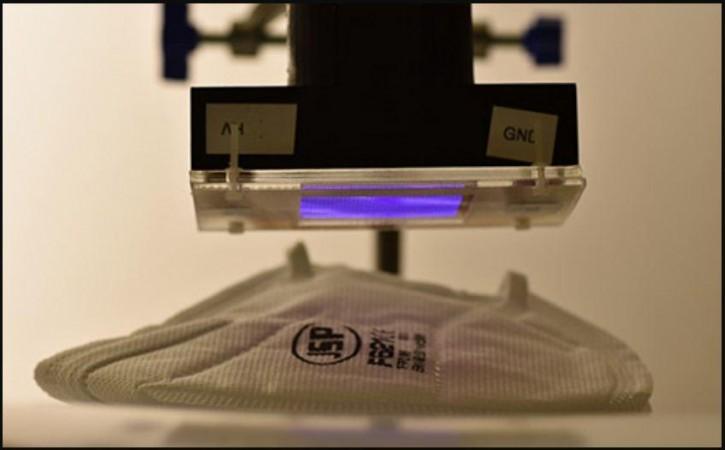The COVID-19 pandemic is ongoing. However, at the height of the pandemic's devastation, the lack of hospital beds was not the only scarcity faced by healthcare systems. The shortage of personal protective equipment (PPE), particularly face masks (N95 and N99), also plagued frontline health workers. Now, scientists have developed a new decontamination method using advanced low-temperature plasma technology to neutralize the SARS-CoV-2 virus for the safe cleaning and reuse of face masks.
In a new study, researchers from the University of Southampton, UK, have described a new disinfection technique utilizing cold plasma that can effectively inactivate the novel coronavirus and make face masks reusable. They found that a 5-minute treatment using cold plasma led to a 4-log or 99.99 percent reduction in the presence of the virus. The findings were published in the journal AIP Advances.
"Although most of the masks are considered one-time use, the reuse of masks may need to be considered as a crisis capacity strategy to ensure continued availability for COVID-19 and future pandemics," said Dr. Min Kwan Kim, lead author of the study, in a statement.
Seeking a Viable Alternative

Currently, several techniques are under trial for the decontamination of PPEs. This includes the use of ultraviolet radiation (UV), moist heat, hydrogen peroxide, and other chemical agents. While these methods are efficient in inactivating the SARS-CoV-2 virus, they can impact the performance of masks negatively. They do so by causing damage to the filter or by leaving residues that can harm the skin.
The authors directed attention specifically to hydrogen peroxide, which finds a place in the Environmental Protection Agency (EPA) N-list as a disinfectant against the novel coronavirus. However, masks that are disinfected using hydrogen peroxide cannot be used immediately as residues of hydrogen peroxide pose the risk of skin damage.
Therefore, the researchers turned to another source that may serve as an alternative sterilization method: Cold plasma. Also known as non-thermal plasma, previous studies have demonstrated that it can rapidly deactivate up to 99.99 percent of different viruses.

While hydrogen peroxide neutralizes pathogen through the production of highly reactive hydroxyl (OH.) radicals, cold plasma does so by generating such OHand O2−. Nevertheless, the mechanisms of both the agents are similar.
Testing a New Technique
For the current study, samples of FFP2 and FFP3 face masks—the most commonly used masks by frontline healthcare workers—were exposed to microdroplets containing the SARS-CoV-2 coronavirus by the team. Utilizing a prototype decontamination system, cold plasma was applied to the sample masks for two, five, and ten minutes.
The prototype system consisted of a power processing unit and a surface dielectric barrier discharge (DBD) plasma generator. DBD plasma delivers a dry treatment that does not result in the generation of waste water or require fabrics to be dried off following treatment

Next, the samples were examined to ascertain whether any residual SARS-CoV-2 was present. The researchers also tested for transmitted aerosols of sodium chloride (NaCl) through facemasks to track filter performance.
99.99 percent Reduction
It was found that the samples that received a five-minute plasma treatment, displayed a 99.99 percent (4-log) reduction of the SARS-CoV-2 virus. Only very few samples continued to harbor the pathogen. A ten-minute treatment was observed to neutralize the virus on all the samples successfully, except in a single case.
Additionally, it was noted that there was no considerable effect on the performance of the filters in either of the tested face masks (FFP2 and FFP3). Also, no phycisal damage was detected in the masks. However, the authors admitted to a key limitation in the new system: in the case of surfaces of masks with complex geometries, they required a guaranteed plasma contact of 10 minutes for total neutralization.
Environmental Benefits

While the new decontamination system provides a contingency strategy that healthcare systems can fall back on in the event of a pandemic and rise in hospitalizations in the future, it can also have significant environmental benefits.
Dr. Kim emphasized, "Environmentalists warn single-use masks are adding to the glut of plastic pollution threatening the health of oceans and marine life. It has been estimated 129 billion single-use face masks are used monthly around the world, with 55 million a day in the UK."
He also pointed out that the disposal of used face masks mostly occurs through incineration or being sent to landfills. "Their continued use on this scale can affect the UK's ambitions to achieve net-zero and reduce plastic waste," concluded Dr. Kim.

















